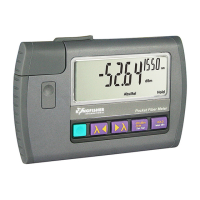CALIBRATION AND MAINTENANCE
Power Meter Calibration
Calibration is a transfer process. It is performed by setting up a light
source at a stable, but non-critical power level between 0 and -30 dBm,
and adjusting the meter reading to the same value as that shown by a
reference meter.
Required are laser and LED light sources with accurate, calibrated
wavelengths and good power stability, a power meter with appropriate
calibrated wavelengths, single mode and multimode test leads. Check
the calibration certificates on your reference equipment to ensure
current validity.
Known calibration constants can be re-entered directly without using
other equipment. This is useful in case old calibration constants are to
be put back.
Record the existing calibration offsets, re-enter or adjust known offsets
at this point or calibrate the meter at the selected wavelength as
follows:
Note: this process may not be as accurate as the original factory
calibration process.
Inserting the 2.54 mm (0.1”) pitch programming shunt across
pins will put the instrument into calibration mode. It will
display ‘CAL’.
Press [] or [] to set the wavelength to be calibrated.
Record the light source power measured by reference power
meter.
Transfer this power level to the meter to be calibrated:
Press [HOLD] to display power reading. Press [HOLD] again
to display current offsets. Record the current (old) value.
Press [HOLD] again, then [] or [] to adjust reading
to match the noted reference reading. Press [HOLD] again
to display current offsets. Record the current (new) value.
Note: Toggling the [HOLD] button will show the power
reading and the offsets on the display.
To set the new value, press and hold [dB/dBm/ mW] until the
instrument beeps. The display will show ‘CAL’ and calibrated
wavelength.
Repeat above process for other wavelengths.

